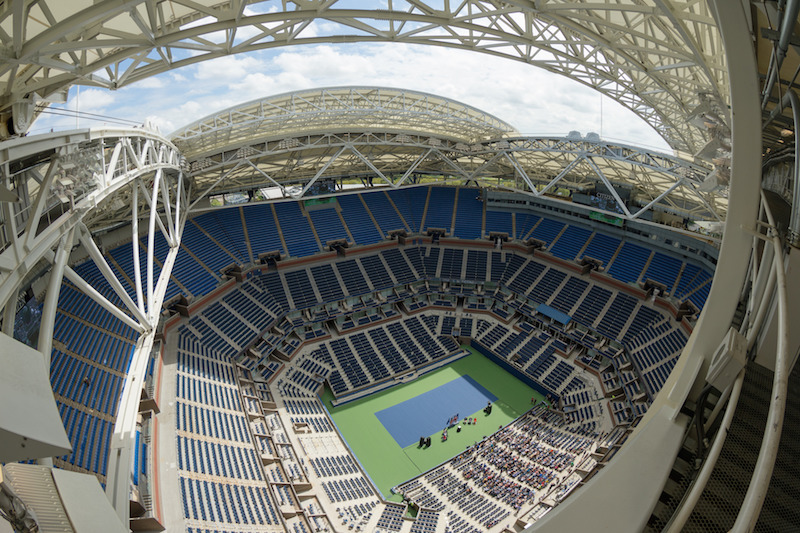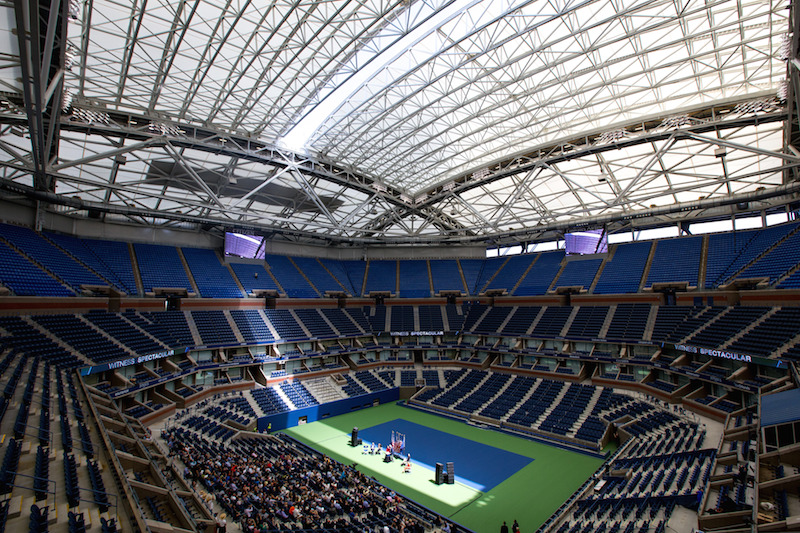As the U.S. Open Grand Slam tennis tournament in New York moves into its second week, the massive retractable roof over the 23,711-seat Arthur Ashe stadium has been drawing oohs and aahs from players and fans alike.
The $150 million roof addition is part of a $550 million renovation of the Billie Jean King National Tennis Center in Flushing, Queens. The roof itself was five years in the making, and posed several structural and engineering challenges to the Building Team, which included the architect Rossetti, the engineering firm WSP | Parsons Brinckerhoff, and the general contractor Hunt Construction Group.
This morning, BD+C interviewed WSP | Parsons Brinckerhoff execs Ahmad Rahimian, P.E., SE, F.ASCE, director of Building Structures; and Yoram Eilon, P.E., Senior Vice President of Building Structures, about this project.
Rahimian noted that any stadium construction or renovation is complicated. This one, though, was unique in several ways. For one thing, there was no precedent to draw upon in the tennis world, as Arthur Ashe is by far the largest stadium on the tour. And that facility, which opened in August 1977, wasn’t designed to include a roof.
Rahimian said that the U.S. Tennis Association (USTA), which owns and operates the venue and annual event, actually started thinking about a roof three years after the stadium opened. Those plans became more urgent in 2008, when rain interfered with the completion of some matches. Since then, rain has been a perennial threat, and occasional impediment, to the tournament’s scheduling. Design discussions for a roof began around 2011, he said.
Given the stadium’s age and structural condition, the Building Team concluded that the best solution would be to build a freestanding structure for the retractable roof that doesn’t touch the stadium itself. (There’s a 15-inch gap between the stadium and the roof pavilion.)
That roof structure sits on eight super-steel columns and 16 great brace angles that rise 125 feet above ground level, and support an 80-foot-high Teflon-covered membrane and two 500-ton panels that move back and forth over a 62,500-sf opening.
The retractable panels move on wheel assemblies mounted on rails, and can be opened or closed by cables and winches in only seven minutes.
The National Tennis Center is located in a marshy part of Queens, so the Building Team had to find answers to soil issues in order to support a roof pavilion that would weigh 6,500 tons. The steel columns are organized in an octagonal pattern that corresponds to the shape of the stadium. Each column is mounted on a concrete pier that spreads the weight load of the pavilion onto an underground concrete slab. That platform is supported by pilings that go as deeply as 180 feet into the ground.
Eilon noted, though, that this wasn’t a simple drilling job, as there are massive amounts of utilities infrastructure underground that needed to be circumvented or rerouted, not to mention the subway and Long Island Railroad systems nearby.
In addition, construction shut down during the two weeks of the tournament, which meant that cranes had to be taken down or relocated.
(Despite New York’s reputation for being a difficult place to get construction done, Rahimiam and Eilon said the city wasn’t at all intrusive. “I think they understood the significance of this to the city,” says Eilon.)

Even when the roof is open, 60% of the stadium's 23,771 seats are shaded. Image: USTA/Jennifer Pottheiser
Even when the roof is open, at least 60% of the stadium seats are shaded. To mitigate condensation and to ventilate the stadium when the roof is closed, the Building Team installed 16 air diffusers along a six-foot-wide duct that encompasses the top of the stadium, the WSP execs confirmed. As cooled air drops into the bowl of the stadium, it’s expelled by mechanical fans.
Rahimian and Eilon say that despite all this HVAC equipment, the stadium is relatively quiet when the roof is closed, although that enclosure does tends the magnify ambient sounds from the audience, which at the U.S. Open are pretty noticeable to begin with.
USTA had budgeted about $100 million for the roof project, but dealing with structural support, condensation, and ventilation tacked on another $50 million to the price tag, says Rahimian.
WSP | Parsons Brinckerhoff is involved in other facets of the National Tennis Center’s renovation, which will include an expanded Grandstand stadium. Whether other sports stadiums embrace retractable roofs, though, remains to be seen. Roland Garros, the location of the French Open in Paris, intends to install a retractable roof to cover its Court Philippe Chatrier, although construction has been pushed back to 2020 at the earliest, according to Tennis Magazine.
Rahimian believes retractable roofs help venues to “justify” their brands, and he expects more projects like these in the future. “I think it’s a trend.”
Related Stories
Hotel Facilities | Apr 24, 2024
The U.S. hotel construction market sees record highs in the first quarter of 2024
As seen in the Q1 2024 U.S. Hotel Construction Pipeline Trend Report from Lodging Econometrics (LE), at the end of the first quarter, there are 6,065 projects with 702,990 rooms in the pipeline. This new all-time high represents a 9% year-over-year (YOY) increase in projects and a 7% YOY increase in rooms compared to last year.
ProConnect Events | Apr 23, 2024
5 more ProConnect events scheduled for 2024, including all-new 'AEC Giants'
SGC Horizon present 7 ProConnect events in 2024.
75 Top Building Products | Apr 22, 2024
Enter today! BD+C's 75 Top Building Products for 2024
BD+C editors are now accepting submissions for the annual 75 Top Building Products awards. The winners will be featured in the November/December 2024 issue of Building Design+Construction.
Laboratories | Apr 22, 2024
Why lab designers should aim to ‘speak the language’ of scientists
Learning more about the scientific work being done in the lab gives designers of those spaces an edge, according to Adrian Walters, AIA, LEED AP BD+C, Principal and Director of SMMA's Science & Technology team.
Resiliency | Apr 22, 2024
Controversy erupts in Florida over how homes are being rebuilt after Hurricane Ian
The Federal Emergency Management Agency recently sent a letter to officials in Lee County, Florida alleging that hundreds of homes were rebuilt in violation of the agency’s rules following Hurricane Ian. The letter provoked a sharp backlash as homeowners struggle to rebuild following the devastating 2022 storm that destroyed a large swath of the county.
Mass Timber | Apr 22, 2024
British Columbia changing building code to allow mass timber structures of up to 18 stories
The Canadian Province of British Columbia is updating its building code to expand the use of mass timber in building construction. The code will allow for encapsulated mass-timber construction (EMTC) buildings as tall as 18 stories for residential and office buildings, an increase from the previous 12-story limit.
Standards | Apr 22, 2024
Design guide offers details on rain loads and ponding on roofs
The American Institute of Steel Construction and the Steel Joist Institute recently released a comprehensive roof design guide addressing rain loads and ponding. Design Guide 40, Rain Loads and Ponding provides guidance for designing roof systems to avoid or resist water accumulation and any resulting instability.
Building Materials | Apr 22, 2024
Tacoma, Wash., investigating policy to reuse and recycle building materials
Tacoma, Wash., recently initiated a study to find ways to increase building material reuse through deconstruction and salvage. The city council unanimously voted to direct the city manager to investigate deconstruction options and estimate costs.
Student Housing | Apr 19, 2024
$115 million Cal State Long Beach student housing project will add 424 beds
A new $115 million project recently broke ground at California State University, Long Beach (CSULB) that will add housing for 424 students at below-market rates. The 108,000 sf La Playa Residence Hall, funded by the State of California’s Higher Education Student Housing Grant Program, will consist of three five-story structures connected by bridges.
Construction Costs | Apr 18, 2024
New download: BD+C's April 2024 Market Intelligence Report
Building Design+Construction's monthly Market Intelligence Report offers a snapshot of the health of the U.S. building construction industry, including the commercial, multifamily, institutional, and industrial building sectors. This report tracks the latest metrics related to construction spending, demand for design services, contractor backlogs, and material price trends.

















